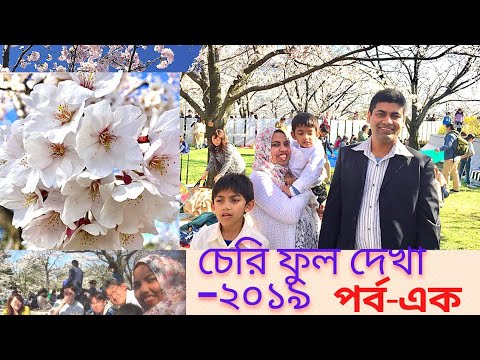Hanami 花見 in the Hakusan Koin白山公園 Niigata Japan||JSPS postdoc fellowship ||Afnans brother
#hanami花見#jspostdocfellowship#cherryblossom#
Hanami (花見, “flower viewing”) is the Japanese traditional custom of enjoying the transient beauty of flowers; flowers (“hana”) are in this case almost always referring to those of the cherry (“sakura”) or, less frequently, plum (“ume”) trees.[1] From the end of March to early May, cherry trees bloom all over Japan,[2] and around the first of February on the island of Okinawa.[3] The blossom forecast (桜前線, sakura-zensen) “cherry blossom front” is announced each year by the weather bureau, and is watched carefully by those planning hanami as the blossoms only last a week or two.
In modern-day Japan, hanami mostly consists of having an outdoor party beneath the sakura during daytime or at night. In some contexts the Sino-Japanese term kan’ō (観桜, view-cherry) is used instead, particularly for festivals. Hanami at night is called yozakura (夜桜) “night sakura”. In many places such as Ueno Park temporary paper lanterns are hung for the purpose of yozakura. On the island of Okinawa, decorative electric lanterns are hung in the trees for evening enjoyment, such as on the trees ascending Mt. Yae, near Motobu Town, or at the Nakijin Castle.
A more ancient form of hanami also exists in Japan, which is enjoying the plum blossoms (梅 ume) instead, which is narrowly referred to as umemi (梅見, plum-viewing). This kind of hanami is popular among older people, because they are calmer than the sakura parties, which usually involve younger people and can sometimes be very crowded and noisy.
History : The practice of hanami is many centuries old. The custom is said to have started during the Nara period (710–794) when it was ume blossoms that people admired in the beginning. But by the Heian period (794–1185), sakura came to attract more attention and hanami was synonymous with sakura. From then on, in both waka and haiku, “flowers” meant “sakura”.
Hanami was first used as a term analogous to cherry blossom viewing in the Heian era novel The Tale of Genji. Although a wisteria viewing party was also described, the terms “hanami” and “flower party” were subsequently used only in reference to cherry blossom viewing.
Sakura originally was used to divine that year’s harvest as well as announce the rice-planting season. People believed in kami inside the trees and made offerings. Afterwards, they partook of the offering with sake.
Emperor Saga of the Heian period adopted this practice, and held flower-viewing parties with sake and feasts underneath the blossoming boughs of sakura trees in the Imperial Court in Kyoto. Poems would be written praising the delicate flowers, which were seen as a metaphor for life itself, luminous and beautiful yet fleeting and ephemeral. This was said to be the origin of Hanami in Japan.
If there were no cherry blossoms in this world
How much more tranquil our hearts would be in spring.
Ariwara no Narihira (825–880)[8]
The custom was originally limited to the elite of the Imperial Court, but soon spread to samurai society and, by the Edo period, to the common people as well. Tokugawa Yoshimune planted areas of cherry blossom trees to encourage this. Under the sakura trees, people had lunch and drank sake in cheerful feasts.
The teasing proverb dumplings rather than flowers (花より団子, hana yori dango) hints at the real priorities for most cherry blossom viewers, meaning that people are more interested in the food and drinks accompanying a hanami party than actually viewing the flowers themselves.
Dead bodies are buried under the cherry trees! is a popular saying about hanami, after the opening sentence of the 1925 short story “Under the Cherry Trees” by Motojirō Kajii.
নিগাতা শহরের অন্যতম প্রধান একটা পার্ক হচ্ছে Hakusan পার্ক । এই পার্কে আমরা চেরী ফুলের উৎসব দেখতে গেছিলাম ১৩ এপ্রিল , ২০১৯ ।
Hakusan Park (白山公園, Hakusan-kōen) is a park in Chūō-ku, Niigata, Niigata Prefecture, Japan.
History
The 1964 Niigata earthquake caused the sandy soil under the city to liquefy, damaging many city facilities. The aging baseball stadium was converted to an earthquake memorial using funds from the earthquake disaster relief money. This is currently the Niigata Prefectural Hall.
From the 1990s, aging facilities were demolished. A riverside picnic site covering approximately 7 hectares was created, and north and south bound traffic was diverted under the park via a tunnel.
JSPS Postdoctoral fellowship in Japan
Higher study in Japan
Japan vlog
Bangladeshi blogger
Japan Society for the promotion of science
Japan
Postdoctoral fellowship in Japan
Niigata University medical and dental science
Niigata University
Science and technology
Niigata, Japan
postdoctoral experience
Japan education vlog
#Hanami 花見
#Cherryblossom
#jspspostdocfellowship
#higherstudyinjapan
#japanvlog
#niigatafestival


AloJapan.com